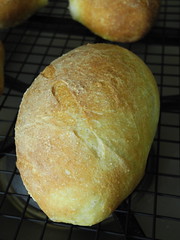 I don't have a strong internal concept of "Italian bread", associating it with loaves grabbed at the grocery store for making garlic bread when you don't want much chew. And that's almost what I got here, just a little better crust and texture. It's a basic white bread with a nice crust, in between an artisan style with interesting texture and a fluffy-texture bread bought for kids' sandwiches...if the kids weren't raised on more interesting bread than that.
I don't have a strong internal concept of "Italian bread", associating it with loaves grabbed at the grocery store for making garlic bread when you don't want much chew. And that's almost what I got here, just a little better crust and texture. It's a basic white bread with a nice crust, in between an artisan style with interesting texture and a fluffy-texture bread bought for kids' sandwiches...if the kids weren't raised on more interesting bread than that.Baking notes: I was halving the recipe, as usual, but forgot to halve the liquid until a lot of it had gone in. I compensated with more flour but kept it more hydrated than called for.

I decided to shape the dough as 4 torpedo rolls plus a batch of breadsticks, soft ones. My breadsticks weren't pretty (how do you transfer thinly rolled breadstick dough to a cooking surface without it stretching irregularly, anyway?), but the concept was clear.


I baked on a sheet pan on top of the baking stone. The torpedo rolls were almost burned on the bottom, like the French baguettes baked directly on the stone the week before. That was with my heaviest sheet pan. Either I've got an unusually heat-retentive baking stone (generic thin 'pizza stone' from somewhere-or-other, nah), the oven is running too hot (not by other evidence, but I'm going to dig out a thermometer), or this is another place where thie results just don't come out quite the way the book says it should.

Results: The breadsticks were good. I suspect any of the other recipes Reinhart says could be used would be interchangeable, as the character of the dough is mostly lost in the thinly rolled, seeded, etc. As for the torpedo rolls, see above: nice even texture, but not a bread I see much reason to repeat. I made a sandwich with one roll, but the rest I think will be used for toasted garlic bread, where the bread itself is secondary.
No comments:
Post a Comment